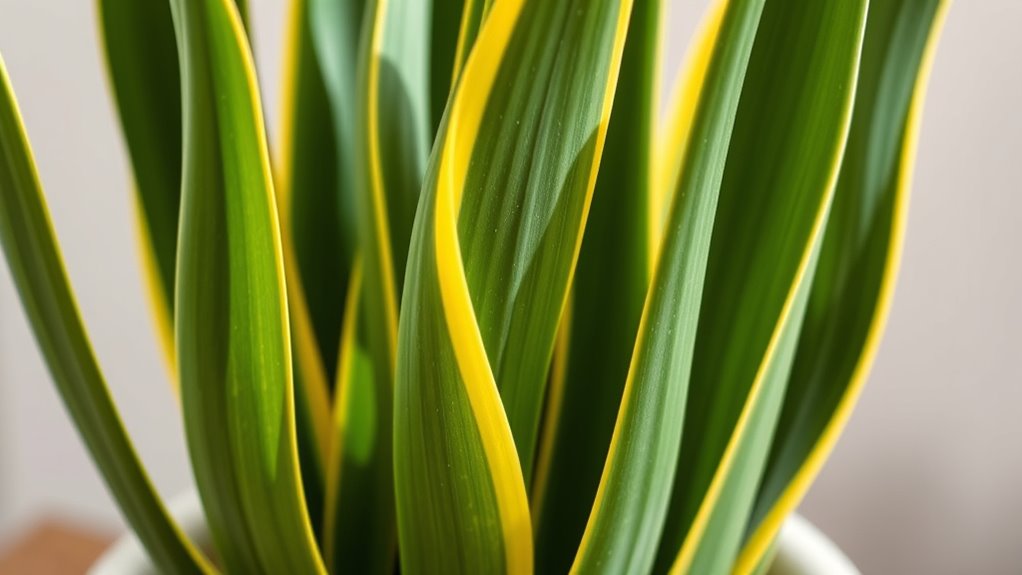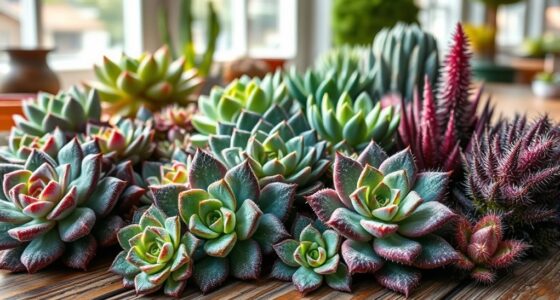To care for your snake plant, water it infrequently—about every 2 to 6 weeks—and let the soil dry out completely between waterings. Make certain it’s in well-draining soil with drainage holes, and place it in bright, indirect light for best growth. Avoid overwatering or heavy soil, as snake plants are very resilient and tolerate neglect. Keep an eye on your plant’s needs, and you’ll discover simple tips to keep it thriving year-round.
Key Takeaways
- Water sparingly every 2 to 6 weeks, allowing soil to dry out completely between waterings.
- Use well-draining soil, like cactus mix or DIY blends with sand or perlite, to prevent overwatering.
- Place in bright, indirect light; tolerate low light but avoid direct sun to prevent leaf scorch.
- Ensure pots have drainage holes and avoid overwatering to maintain healthy roots.
- Monitor soil moisture regularly and extend watering intervals during winter for optimal health.

Snake plants are among the easiest houseplants to care for, making them perfect for beginners. Their resilience and low-maintenance nature mean you don’t have to worry about overcomplicating your plant care routine. One of the most important aspects of keeping a healthy snake plant is understanding its watering schedule. Unlike many houseplants, snake plants prefer infrequent watering. You should allow the soil to dry out completely between waterings, typically every 2 to 6 weeks depending on your home’s humidity and temperature. During the winter months, you can extend this interval even further. Overwatering is a common mistake, leading to root rot and other issues. When you do water, pour enough to moisten the soil thoroughly, but make sure excess water can drain away easily. Always check the soil moisture first; if it still feels damp, wait a few more days before watering again. This approach helps prevent water from sitting around the roots and causing problems.
Equally important is understanding the soil requirements for your snake plant. It thrives best in well-draining soil that prevents excess moisture from lingering around the roots. A cactus or succulent potting mix works well because it’s designed to drain quickly, but if you prefer a DIY approach, you can create your own mix by combining regular potting soil with coarse sand or perlite. Avoid using heavy, dense soils that retain too much water, as this can lead to root rot. When repotting or planting your snake plant, make certain the pot has drainage holes to facilitate proper water escape. This is essential for maintaining the right soil conditions and keeping your plant healthy. Additionally, understanding the environmental considerations such as light levels and humidity can greatly influence your plant’s growth and longevity.
In addition, placing your snake plant in bright, indirect light will help it thrive, but it can tolerate low light conditions as well. Keep it away from direct sunlight that might scorch its leaves. If you notice the leaves stretching or losing their vibrant color, it might need more light. Remember, the key to successful snake plant care is consistency and paying attention to its watering and soil needs. With the right watering schedule and proper soil, your snake plant will grow strong, look attractive, and require minimal fuss. Over time, you’ll appreciate how this hardy plant can adapt to various conditions, making it a perfect addition to any space. Just keep an eye on the soil moisture and make certain it’s well-draining, and you’ll enjoy a healthy, thriving snake plant for years to come.
Frequently Asked Questions
Can Snake Plants Survive in Low Humidity Environments?
You might wonder if snake plants can handle low humidity environments. They actually have a high humidity tolerance and are well-adapted to dry conditions, making them ideal for low humidity settings. Their environmental adaptation allows them to thrive with minimal moisture in the air. So, yes, snake plants can survive and even flourish in environments with low humidity, making them a resilient choice for many indoor spaces.
How Often Should I Prune My Snake Plant?
Think of your snake plant as a sculptor’s masterpiece, needing gentle shaping. You should prune it every couple of months, focusing on removing yellow or damaged leaves. Use pruning techniques like snipping at the base to manage growth and keep it looking sleek. Regular pruning encourages healthy growth and prevents it from becoming unruly, making your plant a stunning, low-maintenance focal point in your space.
Are Snake Plants Safe for Pets?
You might wonder if snake plants are safe for pets. The truth is, snake plant safety is a concern because it’s a known pet toxin. If your pet nibbles on a snake plant, they could experience symptoms like nausea or vomiting. To keep your furry friends safe, it’s best to place your snake plant out of their reach or choose pet-safe houseplants instead.
What Are Common Pests That Affect Snake Plants?
Imagine your snake plant as a fortress, but pests like spider mites, mealybugs, and scale insects are sneaky invaders trying to breach it. To keep them out, practice pest prevention by inspecting regularly and maintaining healthy conditions. If you spot pests, natural remedies like neem oil or insecticidal soap work wonders without harm. Staying vigilant guarantees your plant remains resilient and pest-free, just like a well-guarded fortress.
How Do I Propagate My Snake Plant at Home?
To propagate your snake plant, choose healthy leaf cuttings or division methods. For leaf cuttings, cut a leaf near the base, let it callus, then plant it in well-draining soil. Dividing the root ball works well for mature plants. Observe root growth patterns—roots typically develop from the cut or division point. Keep soil slightly moist, and soon you’ll see new roots forming, ensuring your snake plant thrives.
Conclusion
Now that you know the secrets to keeping your snake plant thriving, imagine what else you could achieve with it by your side. Will you discover new ways to enhance your space or reveal hidden plant potential? The journey doesn’t end here—your unkillable houseplant is just waiting for you to take the next step. Get ready, because your green thumb might just surprise you in ways you never expected. The adventure is only beginning.









